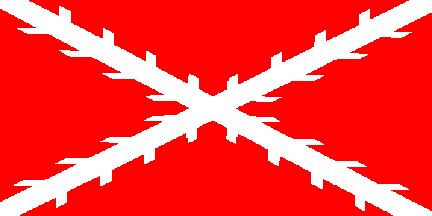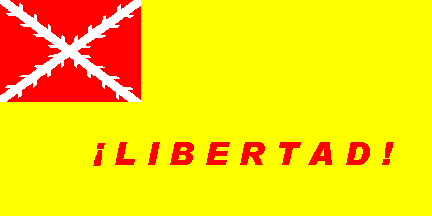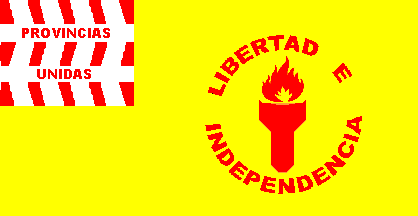This is an old revision of the document!
Table of Contents
United Provinces of South America (Look to the West)
In Look to the West, this state is roughly the equivalent of OTL's United States of America. It grew from two sources - the First Platinean War between Spain and Portugal in which it was perceived that Spain had abandoned the Rio de la Plata colonists, and the exile of the Spanish and Portuguese chief ministers there after the war, who stirred up radicalism as a means of gaining support, but then died before they could use it and the country rose up by itself.
The catalyst for the UPSA's formation was the rebellion of Tupac Amaru II in Peru, supported by Britain in the Second Platinean War. Initially the Spanish colonists were inclined to look dimly on such an Indian rebellion, but then troops of Spain's ally in the war, France (who were not entirely aware that they were supposed to be allied) effectively sacked Buenos Aires and the people of La Plata rose up, soon joined by those in OTL Bolivia and Peru. The rebellion eventually resulted in all the Viceroyalty of Peru (the Viceroyalty of Rio de la Plata never having been formed in TTL) going to the new independent state, leaving Spain with only New Spain and New Granada.
The UPSA picked up many French soldiers who decided to settle there after their trapped army was forced to surrender to Anglo-U.P. forces, some of whom would have gone on to do great things for France in OTL, but instead became influential figures in the UPSA.
The people are often known as Meridians, derived from the Latin name for South America, America Meridionalis.
System of Government
The UPSA was a republic, but not as radical as its equivalent the USA, and in some ways more like an elective monarchy. The President-General, who was elected for life according to the constitution by (nearly) universal male suffrage, has strong executive powers, while legislative powers rest with the Cortes Nacionales. The UPSA takes the early Dutch Republic as its main inspiration.
Within the UPSA several Indian states were set up, a result of the original rebellions, which are U.P. protectorates but not part of the UPSA as such. They included the restored Tahuantinsuya Empire and the Aymara Kingdom.
One important (and radical) founding principle of the UPSA is that all men have equal rights, abolishing the limpieza system by which the proportion of Spanish blood determined rights and privileges. The Meridians practice what they preach when it comes to Peninsulares (whites born in Spain), Criollos (whites born in America), Mestizos (white/Indian mixed race people) and most Indians, but generally do not treat blacks or people with black ancestry equally.
After the upheavals of the Third Platinean War, resulting in the loss of Peru (and the destruction of the Tahuantinsuya protectorate) and the disintegration of the ruling Partido Solidaridad, the constitution was amended to limit the President-General to three-year terms requiring re-election. Convention resulted in most Presidents-General not seeking re-election, with the result that this was eventually changed to a single six-year term.
List of Presidents-General
1785-1794: Simón Riquelme de la Barrera Goycochea (non-partisan; initially provisional, first formally elected in 1790)
1794-1802: Miguel de Azcuénaga (non-partisan conservative; assassinated)
1802-1807: Juan José Castelli (Partido Solidaridad; killed by an angry mob)
1807-1810: Miguel Baquedano y Zebreros (Reagrupamiento por la Unión; seized power in a coup)
1810-1813: Roberto Enrique Mateováron Domínguez (Amarillo Party)
1813-1816: José Jaime Carriego López (Amarillo Party)
1816-1819: Pablo Portillo de Insaurralde (Colorado Party)
1819-1822: Alfredo Maria Vallejo y Rodriguez (Amarillo Party) (First Term)
1822-1825: Alfredo Maria Vallejo y Rodriguez (Independent Amarillo) (Second Term)
1825-1831: Sebastián Carlos Velasco Serrano (Colorado Party, then “Velasco's Coalition”–later the Adamantine Party–after 1829)
1831-1837: Felipe Ricardo Riquelme González (Adamantine Party)
1837-????: Rámon Almada Dominguez (Adamantine Party)
Religion
The UPSA is emphatically not secular, unlike the USA of OTL. The population is mainly Catholic, but with a strong Jansenist streak. While the Papacy has banned the Jesuits, the UPSA - along with Russia - continues to allow them to work there. The First Platinean War was partly about the right to Jesuit missions over the River Plate and so the Jesuits are inextricably bound up with the UPSA's founding mythos.
Some of the Indian states retain elements of their traditional religions, but usually combined with at least an influence from Catholicism.
Flag
The UPSA originally rebelled under the Spanish colonial flag (cross of Burgundy) with colours reversed. Later it was reused as a naval jack.
The UPSA used the following flag from the middle of the Second Platinean War to its constitutional establishment in the late 1780s:
The flag was modified with a new 'Torch of Liberty' seal, and the Burgundian cross was turned into a less obviously Spanish-derived symbol. It was henceforth used as the definitive national flag:
Variants of that flag, with the traditional Tahuantinsuya and Aymara rainbow colours, was used by the Indian protectorates of the UPSA:




